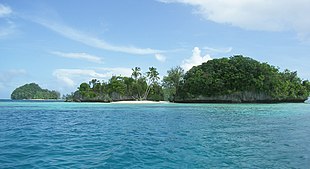
Back اقتصاد بالاو Arabic Economia de Palau Catalan Economía de Palaos Spanish Économie des Palaos French Economía de Palau Galician Պալաուի տնտեսություն Armenian Ekonomio di Palau IO Economia de Belau Occitan Экономика Палау Russian Ekonomia e Palaut Albanian
This article has multiple issues. Please help improve it or discuss these issues on the talk page. (Learn how and when to remove these messages)
|
 Rock Islands in Palau – Such scenery has helped invite tourism and build up Palau's economy. | |
| Currency | United States dollar |
|---|---|
| 1 October – 30 September | |
| Statistics | |
| GDP | $257,700,000 |
GDP growth |
|
GDP per capita | |
GDP by sector | agriculture (3%), industry (19%), services (78%) (2016 estimate)[2] |
| 1.574% (2018)[1] | |
All values, unless otherwise stated, are in US dollars. | |
The economy of Palau consists primarily of subsistence agriculture and fishing. The government is the major employer of the work force, relying heavily on financial assistance from the United States. The population enjoys a per capita income of more than twice that of the Philippines and much of Micronesia. Long-term prospects for the tourist sector have been greatly bolstered by the expansion of air travel in the Pacific and the rising prosperity of leading East Asian countries.
Palau's per capita GDP of $17,000 makes it one of the wealthier Pacific Island states. Nominal GDP increased by an annual average of nearly 14% from 1983 to 1990, and by an annual rate of over 10% from 1991 to 1997. Growth turned sharply negative in 1998 and 1999 as a result of the 1997 Asian financial crisis.
- ^ a b c d "World Economic Outlook Database, October 2019". IMF.org. International Monetary Fund. Retrieved 20 October 2019.
- ^ "The World Factbook – Palau". Central Intelligence Agency. Retrieved July 1, 2019.